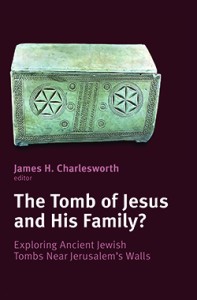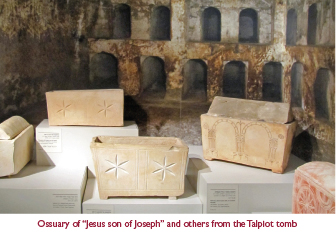The Tomb of Jesus and His Family?

It’s interesting to think that there is no archaeological evidence for the existence of Jesus Christ, or any of his followers. The Talpiot tomb has come close to proving the burial of Jesus and family, and I personally believe it has, but the excavation has been so badly botched that all interested factions can object to the findings. Christian fundamentalists object because they see a threat to their faith in the resurrection. Then there are authors who object because they have made a career writing books that say Jesus never existed. The Jewish archaeologists who investigated the tomb are defensive because they blew the greatest find in history. In the end, the debate will never be resolved, but at least it will open the eyes of some to the real historical Jesus and how a simple Jewish carpenter was deified.
Some facts are undeniable: The Talpiot tomb was unearthed during a construction project in 1980. Ten ossuaries were found and cataloged but one “went missing.” The others are stored with the names noted by the Israel Antiquities Authority (IAA). Ossuaries, carved limestone boxes containing bones after the flesh has rotted away, were a common practice of burial in Israel from about 100 BCE to the destruction of Jerusalem in 70 CE, and thousands have been found and stored. When found, bones are removed and reburied anonymously as required by today’s Orthodox Jews, a practice severely lacking in historical foresight.
The first archaeologist to examine the tomb was recently quoted by his widow on the news that he believed he had found the tomb of Jesus but was fearful of revealing it. Names were carved on six of the ten ossuaries and have been read as: Jesus son of Joseph, Maria, Mariamne kai Mara, Jose, Judah son of Jesus, and Matthew.
The Mariamne name has been attributed to Mary Magdalene based on later uses of this form of the name. This interpretation is contested in The Tomb of Jesus and His Family? edited by James H. Charlesworth of the Princeton Theological Seminary. The statistical probability that the names correspond to Jesus and family members mentioned in the gospels is the main reason for the suggestion that the tomb is that of Jesus.
The news of the Talpiot tomb was first expounded in the BBC documentary by Ray Bruce, The Body in Question,
in 1996. But the main notoriety was in Simcha Jacobovici’s 2007 Discovery Channel documentary The Lost Tomb of Jesus (James Cameron was the executive producer), and Jacobovici’s book, The Jesus Family Tomb, co-authored by Charles Pellegrino. They make the case that the tomb is that of Jesus and family based on the statistical match of the names compared to the names in the gospels. They also give evidence that the missing ossuary is the famous James ossuary with the carved label: James son of Joseph, brother of Jesus. The evidence is the unique match of the elemental analysis of the patina that forms over the eons on the limestone surface. The patina matches that on the Talpiot ossuaries, but doesn’t match patina from other tombs. To me, this is convincing, but more comparisons with ossuaries from other tombs need to be done.
The James ossuary is the “slam dunk” in the statistical analysis, but it was unfortunately stolen in the initial incompetence, probably by someone hoping for money. Incidentally, it was purchased on the antiquities market in 2002. The owner went through a seven-year forgery trial on charges that the words “brother of Jesus” were added. No fraud was found.
After the uproar over the 2007 book and documentary, Charlesworth organized this more scholarly investigation, assembling distinguished scholars to evaluate the findings without sensationalism. Charlesworth states at the outset that he doesn’t think the tomb is that of Jesus and family, adding that, “Too often publications and debates devoted to the Talpiot tomb were shaped by unscientific methodologies and emotional assumptions.” The purpose of the symposium was to clarify facts, not reach a consensus, but he feels that a consensus formed that the tomb is not that of Jesus of Nazareth. But after reading the 575 pages myself, I don’t get that impression.

(CC BY-SA 3.0) Tamarah/Via Wikimedia Commons
The Tomb of Jesus and His Family? contains reports of twenty-eight scholars, and covers a whole range of questions, such as: Are the names accurately read, especially the name attributed to Mary Magdalene? Does her ossuary contain bones of one person or two? Would Jesus be called son of Joseph? Why not Jesus of Nazareth? Why would the tomb be in Jerusalem and not Nazareth? What do the statistics really indicate? Was Jesus married? Did he have a son? Is the James ossuary from the Talpiot tomb? And most importantly, would the discovery of Jesus’s bones destroy faith in the resurrection? This question leads to more inquiry into what early Christians believed about the resurrection; was it a body or a spirit that rose, for example.
My favorite chapter is by James D. Tabor, whose blog (Jamestabor.com) I find corresponds with my take on Christian origins. He states: “I am convinced that there is a surprisingly close fit between what we might postulate as a hypothetical pre-70 CE Jesus family tomb based on our textual records correlated with this particular tomb in Talpiot and its contents.” He expounds on the statistical rarity of the names, the evidence for Mary Magdalene, and that Jesus’s brother Jose is mentioned in the gospel of Mark, 6:3. Tabor doesn’t consider the tomb an attack on faith, since he believes it gives evidence that Jesus really existed.
The last chapter by Charlesworth discusses the “Patio tomb,” which is near the Talpiot tomb but hasn’t been opened. The Orthodox forbade opening, but allowed a robotic arm to photograph the ossuaries. The archaeology is the subject of the book, The Jesus Discovery, by Tabor and Jacobovici. One of the ossuaries is very ornate with a drawing of a fish spitting out a stick figure of a man with the name YONAH (Jonah). Jesus had said (Matthew 12:38-41) that Jonah would be a sign. This suggests that in a nearby tomb, there are early followers of Jesus who were obviously wealthy and lends support to the thesis that the Talpiot tomb contained Jesus and family.
Missing among the book’s scholars is anyone who believes Jesus is entirely mythological—a significant oversight since there are apparently many of this persuasion, as reported by Bart D. Ehrman in his book, Did Jesus Exist? Ehrman and Tabor would argue that there are just too many details in the gospels to say there is no basis. I agree, but I am impressed with the thinking of Joe Atwill in Caesar’s Messiah. He thinks the gospels were written in Rome with support of Emperor Titus who had recently destroyed Jerusalem. Titus hoped to pacify the rebellious Jews by promoting a peaceful messiah who would render to Caesar. No doubt, Paul’s otherworldly messiah was a good fit.
This hypothesis answers the question of where the gospels came from and how they were financed.
Putting it all together, I think the Talpiot tomb is that of Jesus and family. The Jesus movement headed by James was influential in Jerusalem and had many followers. Jesus’s bones were likely buried in an ossuary, and it makes sense that later other family members were added.
How could the reports of resurrection have spread? When Jesus’s body was moved, rumors spread that he had risen. The earliest version of Mark’s gospel reports no sightings. Later gospels based on oral and Q-source writings embellished Mark with stories of a virgin birth, miracles, and resurrection appearances. Several chapters of the book contend that early Christians could still believe in the resurrection as a spirit while the body remained.
In the end, examinations of the Talpiot tomb can increase awareness of the questions surrounding the historical Jesus. By promoting scholarly inquiry like Charlesworth’s we can gain a clearer understanding of what really happened, and significantly help demythologize the belief that Jesus was a God who died for our sins. ![]()
